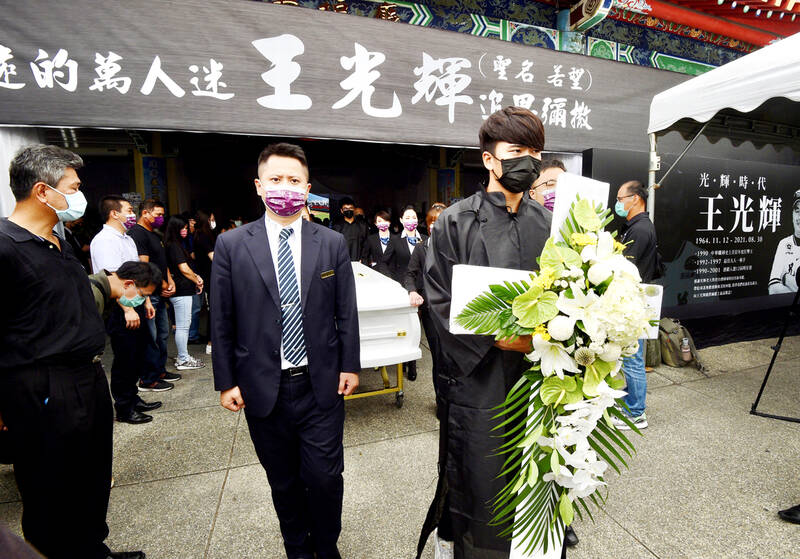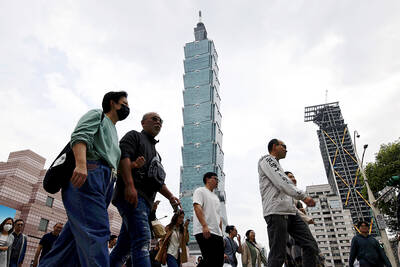The death of Queen Elizabeth II has plunged the royal household and much of the UK into a period of mourning, with black armbands and flags at half mast. While such traditions may seem far removed from everyday experiences of bereavement, experts say rituals can help us cope with death.
“Mourning plays an important role in bereavement because it’s a way of externalizing the emotions and thoughts of grief and, through that, incorporating the loss into your life and beginning to heal,” said Lucy Selman, an associate professor in end-of-life care at the University of Bristol and the founding director of Good Grief Festival.
Mary-Frances O’Connor, an associate professor of psychology at the University of Arizona and the author of The Grieving Brain, agrees that traditions are important.

Photo: Lo Pei-der, Taipei Times
“Mourning rituals can offer constancy and comfort in a moment when everything can feel very uncertain,” she said. “By connecting us to rituals that have existed for hundreds of years, we are reminded that those who came before us have experienced grief and uncertainty, and they have carried on and restored meaningful lives.”
Selman said markers of mourning such as armbands could help identify those who are grieving and act as indicators to others to respect and offer comfort or support to the bereaved.
This could be useful, she said. According to a YouGov survey released in January, 30 percent of adults in the UK who had been bereaved found others not referencing their loss at all.
“If we had armbands or similar, perhaps grief would be less easy to ignore,” said Selman.
O’Connor also said outward cultural signs of mourning could be beneficial, but she noted that the way we express grief changes vastly over time and across cultures.
“What is important is an expression of grief that is meaningful to you, your family or your community,” she said. “There are many cases where black armbands would be appropriate, but expressions of condolences on Twitter are completely modern but no less meaningful.”
Chao Fang, a research fellow at the Center for Death and Society at the University of Bath, said the mourning traditions employed by the royal household offer a shared and personal platform to express grief, and enabled a smooth transition from loss. He said that made them a valuable way to encourage bonds and empathy among family, community and wider society in the face of death.
But with society becoming increasingly diverse, it is important to explore new customs and rituals, he said.
“No matter if we draw upon past traditions or create new and personalized rituals, at the heart of our endeavors to mourn and grieve is to love, to remember and, ultimately, to find our own way to live with loss,” Fang said.
Andy Langford, the clinical director of the charity Cruse Bereavement Support, said the pandemic’s disruption of funerals and other milestones for expressing grief had made bereavement much more painful for thousands of people.
Although these rituals have returned, Langford said more could be done.
“A fixed mourning period for everyone experiencing a personal bereavement is unlikely to cover every eventuality, but it would go a long way to society being kinder to those grieving,” he said.
“The expectation that grief has a short timeline and we should be over our bereavement in a few weeks is outdated. This morning period we are seeing unfold for Her Majesty shows the need to take proper time to mourn. But 10 days is just the start of the grief process.”
Langford said greater emotional support was needed for those who have been bereaved, including through funded specialist services, as well as better bereavement policies for employees, expanded statutory bereavement leave and a dramatic reduction in the administrative burden after someone dies.
O’Connor also stressed the need for employers to support bereaved staff.
“In our 24/7 world, many people find it difficult — or are not able — to take time for grieving. However, as human beings, we still need a time and space to pause, to mourn, to adjust to what it means for us that someone has died,” she said.

In the March 9 edition of the Taipei Times a piece by Ninon Godefroy ran with the headine “The quiet, gentle rhythm of Taiwan.” It started with the line “Taiwan is a small, humble place. There is no Eiffel Tower, no pyramids — no singular attraction that draws the world’s attention.” I laughed out loud at that. This was out of no disrespect for the author or the piece, which made some interesting analogies and good points about how both Din Tai Fung’s and Taiwan Semiconductor Manufacturing Co’s (TSMC, 台積電) meticulous attention to detail and quality are not quite up to

April 21 to April 27 Hsieh Er’s (謝娥) political fortunes were rising fast after she got out of jail and joined the Chinese Nationalist Party (KMT) in December 1945. Not only did she hold key positions in various committees, she was elected the only woman on the Taipei City Council and headed to Nanjing in 1946 as the sole Taiwanese female representative to the National Constituent Assembly. With the support of first lady Soong May-ling (宋美齡), she started the Taipei Women’s Association and Taiwan Provincial Women’s Association, where she

It is one of the more remarkable facts of Taiwan history that it was never occupied or claimed by any of the numerous kingdoms of southern China — Han or otherwise — that lay just across the water from it. None of their brilliant ministers ever discovered that Taiwan was a “core interest” of the state whose annexation was “inevitable.” As Paul Kua notes in an excellent monograph laying out how the Portuguese gave Taiwan the name “Formosa,” the first Europeans to express an interest in occupying Taiwan were the Spanish. Tonio Andrade in his seminal work, How Taiwan Became Chinese,

Mongolian influencer Anudari Daarya looks effortlessly glamorous and carefree in her social media posts — but the classically trained pianist’s road to acceptance as a transgender artist has been anything but easy. She is one of a growing number of Mongolian LGBTQ youth challenging stereotypes and fighting for acceptance through media representation in the socially conservative country. LGBTQ Mongolians often hide their identities from their employers and colleagues for fear of discrimination, with a survey by the non-profit LGBT Centre Mongolia showing that only 20 percent of people felt comfortable coming out at work. Daarya, 25, said she has faced discrimination since she